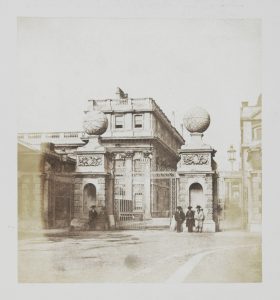The West Gate Globes
Wed 12 Apr 23
The twin domes of the Chapel and Painted Hall are instantly recognisable and form the logo for the Old Royal Naval College. Almost as iconic is the West Gate with its pair of massive Portland stone globes each six feet in diameter and weighing almost seven tons.
The globes were installed in the early 1750s to commemorate the Voyage Round the World of Commodore George Anson. This distinctly out-of-the-ordinary expedition was devised as a way of harrying the Spanish in the Pacific, attacking towns along the West Coast of South America, fomenting rebellion against Spanish colonial rule in Peru and capturing Spanish treasure ships. It was part of a strategic attack on Spain in order to gain further freedom for the ships of the British Empire to trade in produce and enslaved people.
After a catalogue of delays and problems, six ships and around 1900 men sailed from Spithead in September 1740. Four years later, one of the original six, the Centurion, limped back to Spithead with 188 men of the original complement. But despite the enormous losses of men and ships (in fact two of the ships had turned back before reaching the Pacific and returned to England) the expedition was celebrated as a resounding success.
The Centurion had taken the Spanish treasure ship Nuestra Señora de Covadonga (Our Lady of Covadonga) and brought back captured treasure worth around a million pounds, over £100 million in today’s money. This treasure was paraded through the streets of London and Anson became a hero overnight. An account of the voyage, published the following year, was an instant best-seller and it is still a gripping tale of survival and ultimate triumph. Even though the system of prize money distribution heavily favoured the ships’ officers, the magnitude of Anson’s treasure meant that even the lowest ranks of the crew received enough for an immediate and comfortable retirement. It may have been this that prompted the decision to install the globes on the gates of the Royal Hospital. What better advertisement for joining the Navy?
It is very unlikely that any of the Pensioners inside the gates were survivors of the voyage, who should have had no need of the Hospital’s benefits. However, sailors were notorious for running through funds alarmingly fast once they got ashore, so maybe a survivor will emerge from the records. However, from 1754 until his death in 1757, one of the surviving officers, Justinian Nutt, was 3rd Captain of Greenwich Hospital. In his will he left money to his two sons, the elder of whom is called George Anson Nutt. One of his executors was Sir Percy Brett, another Anson voyage veteran, who lived fairly locally at Clock House and is buried in St George’s Church Beckenham.
The gates were originally positioned much closer to the King Charles and King William Buildings and the town of Greenwich extended almost up to the walls of the Hospital. Following the clearance of shops and dwellings and the extension of the Hospital grounds, the gates were moved to their current position in 1850.

It is fascinating to think of the thousands of different people who have passed beneath these globes over the past 270 years, from Greenwich Pensioners and their nurses, Naval officers and trainees, to today’s school children and students, and now, once again, our very welcome visitors.


